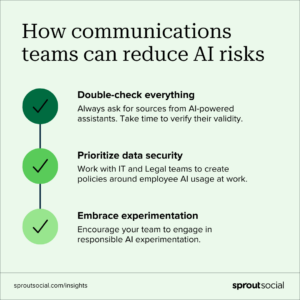
Bots Can Handle Mundane Tasks So Humans Have More Creative Time
Artificial Intelligence impacts many fields of endeavor, including professional communicators. Like other fields, AI’s impact on communicators can range from positive to disastrous. The big question is whether communicators can afford to avoid experimenting with AI to remain competitive.
AI can assist communicators build media lists, identify locations for public events, conduct basic research, manage workflow and comb through large data sets. A recent ad for rAI, a service offered by Resonate to marketers, promised insights in the form of “unrivaled real-time consumer understanding with unparalleled depth, precision and scale.”
AI is less helpful in finding the human angle to a story or telling a story in a compelling, accurate way. AI is ill-equipped to identify and filter out sexist and racist content on the internet.
 “Right now, it’s great to use as a reference or resource tool,” says Ericka Pittman with Epitome Solutions. “But as professionals and human beings, we’re ultimately responsible for the communications and messaging we’re putting out to the world or using internally. It’s helpful, but AI isn’t the end-all-be-all for communicators crafting great messages.”
“Right now, it’s great to use as a reference or resource tool,” says Ericka Pittman with Epitome Solutions. “But as professionals and human beings, we’re ultimately responsible for the communications and messaging we’re putting out to the world or using internally. It’s helpful, but AI isn’t the end-all-be-all for communicators crafting great messages.”
As AI programs are adapted for uses such as digital maps and assistants, it’s likely AI will be used to support communications. Online searches using advanced AI could look for suitable images, hunt for obscure details, analyze data sets or suggest an outline for a fact sheet. A digital assistant might even churn out a routine press release. Those would be time-saving, value-added uses of the technology. And bots don’t take lunch breaks or sleep at night.
One AI observer said the communications industry could be revolutionized with bots taking over mundane tasks, leaving creative tasks to their human overlords. Programs on the market like Journey AI and Replika already sport tagines like “AI devoted to you” and “the AI companion who cares.”
AI and Higher-Order Tasks
It gets dicier when communicators turn to AI for higher-order tasks such as determining the most compelling argument, intermixing quotes appropriately in a story or choosing the right vehicle to convey a key message. Those are distinctly human tasks not suitable, at least for now, to delegate to a device.
Fears that AI could replace professional communicators seem unwarranted. Human judgment is required to weed out material AI fetches that is racist, sexist or inaccurate, drawn from an internet choked with misinformation and disinformation. A bot may not recognize it. Bots also can commit plagiarism. A busy communicator, over-reliant on bots, needs to be on the lookout for lies, tropes or literary thefts.
Policing bot-produced content could become its human co-pilot’s full-time job, especially if further advanced AI system can “think” as well as assemble. The exchange could resemble a chess match with both sides trying to outsmart the other.
Role confusion could develop as AI systems assume the role of communications companion or member of a project team. AI can increase productivity by relieving team members of rudimentary tasks, allowing everyone more time and energy to zero in on the most effective message.
One communicator says he uses AI as a starting point for creative ideas. Another communicator describes how she used AI to sharpen press release titles. A common use is collecting insights through social media sentiment analysis, including analysis in multiple languages.
 An optimistic view is that more advanced AI systems can extend a communicator’s creative horizons. “AI isn’t limited by human imagination, so it can potentially generate TV show pilots, text prompts and nonstandard answers to questions that human brains might not come up with,” explains Marina Anderson in an article for Forbes. “Some people call this AI remixing since it’s taking a huge amount of human information and creating new iterations of it. This makes it a nearly endless source of creative inspiration for new projects. In fact, Netflix is already well known for using sophisticate AI algorithms when deciding whether or not to develop new content.”
An optimistic view is that more advanced AI systems can extend a communicator’s creative horizons. “AI isn’t limited by human imagination, so it can potentially generate TV show pilots, text prompts and nonstandard answers to questions that human brains might not come up with,” explains Marina Anderson in an article for Forbes. “Some people call this AI remixing since it’s taking a huge amount of human information and creating new iterations of it. This makes it a nearly endless source of creative inspiration for new projects. In fact, Netflix is already well known for using sophisticate AI algorithms when deciding whether or not to develop new content.”
“There is no denying that AI can broaden the scope of what humans believe is possible,” Anderson says, “and lead us to new creative heights that we cannot even imagine yet.”
Competitiveness and Experimentation
Ronnie Gomez, writing for Sprout Social, encourages thinking about how AI will transform communication, not replace communicators. She underscores the need to double-check what bots produce, set ground rules on how and when AI should be applied and ensure data security.
 Gomez says AI poses risks, but so does ignoring AI’s capabilities. “Artificial intelligence is here to stay,” she adds. “We’ll continue to find more applications for AI in communications, media and PR. To avoid falling behind, it is essential to encourage your team to experiment frequently with AI technology.”
Gomez says AI poses risks, but so does ignoring AI’s capabilities. “Artificial intelligence is here to stay,” she adds. “We’ll continue to find more applications for AI in communications, media and PR. To avoid falling behind, it is essential to encourage your team to experiment frequently with AI technology.”
“Artificial intelligence can be a powerful ally in the ever-evolving world of corporate communication,” Gomez concludes. “When we combine AI with human expertise, we open ourselves up to a new era of communication that allows professionals to connect, resonate and drive success at scale.”
In other words, rapidly advancing AI may pose existential threats, but not exploring its potential to save time, deepen insights and allow greater creativity may be an existential competitive threat.




